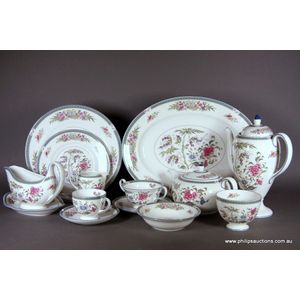Mid-century Sarreguemines Amazonas Dinner Service Set
You must be a subscriber, and be logged in to view price and dealer details.
Subscribe Now to view actual auction price for this item
When you subscribe, you have the option of setting the currency in which to display prices to $Au, $US, $NZ or Stg.
- Circa - A Latin term meaning 'about', often used in the antique trade to give an approximate date for the piece, usually considered to be five years on either side of the circa year. Thus, circa 1900 means the piece was made about 1900, probably between 1895 and 1905. The expression is sometimes abbreviated to c.1900.
- Creamware - Creamware, also known as "Queens Ware" is the
cream-coloured English earthenware developed by Josiah Wedgwood in the 1760s.
The invention of creamware was the result of experimentation in order to find a
British substitute for imported Chinese porcelain, and the cream colour was
considered a fault at the time. The lightweight fine white earthenware with a
clean rich yellowish proved ideal for tableware
and decorative items during the 18th and 19th centuries and is still produced
today.
Creamware is made from a
mixture of kaolin, feldspar, and ball clay, and is typically glazed before
firing to give it its glossy finish. It was developed by British potters as a
cheaper alternative to porcelain.
At Wedgwood, Royal patronage
boosted sales. In 1765 Queen Charlotte, the consort of King George III placed
an order for a 12 place tea set and allowed Wedgwood to use the name
"Queens Ware" for the line. In 1770 Wedgwood produced a creamware
dinner service of 952 pieces supplied to Catherine II the Great of Russia.
Other potteries such as
Doulton, Neale & Co. and Spode produced smaller quantities of creamware.
Creamware continued to be
made throughout the 19th century and later.
This item has been included into following indexes:
Visually similar items

A Sixty seven piece Wedgwood 'Kingston' dinner service 1981-1987, production period, pattern 4677, comprising: nine dinner plates, seven entree plates, seven soup coupes and six saucers, eight side plates and eight dessert bowls, seven cups and saucers, a

A Royal Crown Derby 'Posies' part dinner and tea service. Variously dated, sixty pieces. The finely lobed and scallop edged service decorated with loose bunches and sprigs of coloured Summer flowers comprising: six dinner and ten entree plates, six soup bo

A fine pair of Meissen floral cabinet plates, circa 1740s. The cabinet plates with informally painted loose sprays and sprigs of tulips, convolvulus and others in a predominantly puce, muted blue, and lemon palette, the shaped plates with brown edged rims;

Herend, coffee service 'Bouquet de fruits' pattern, comprising one coffee pot with yellow rose finial, one milk jug, one leaf shaped sugar bowl, four cups and four saucers, one oval tray with pink bow decoration, blue printed and impressed Herend marks to
